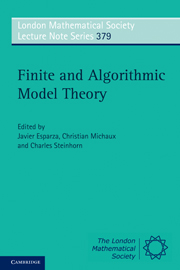Book contents
- Frontmatter
- Contents
- Preface
- 1 Automata-based presentations of infinite structures
- 2 Logical aspects of spatial databases
- 3 Some connections between finite and infinite model theory
- 4 Definability in classes of finite structures
- 5 Algorithmic meta-theorems
- 6 Model theoretic methods for fragments of FO and special classes of (finite) structures
- Bibliography
4 - Definability in classes of finite structures
Published online by Cambridge University Press: 01 June 2011
- Frontmatter
- Contents
- Preface
- 1 Automata-based presentations of infinite structures
- 2 Logical aspects of spatial databases
- 3 Some connections between finite and infinite model theory
- 4 Definability in classes of finite structures
- 5 Algorithmic meta-theorems
- 6 Model theoretic methods for fragments of FO and special classes of (finite) structures
- Bibliography
Summary
Introduction
This paper provides an overview of recent work by the authors and others on two topics in the model theory of finite structures. The point of view here differs from that usually associated with the term ‘finite model theory’, as presented for example in [21] or [46], in which the emphasis and motivation come primarily from computer science. Instead, the inspiration for this work has its origins in contemporary (infinite) model theoretic themes such as dimension, independence, and various measures of the complexity of definable sets. Each of the topics deals with classes of finite structures for first-order logic that are isolated by conditions that are drawn from these model-theoretic considerations. Moreover, in both cases, connections exist to areas in infinite model theory such as stability and simplicity theory, and o-minimality. This survey is intended for both mathematical logicians and computer scientists whose work focuses on logical aspects of the subject.
The first theme concerns asymptotic classes of finite structures. This subject has its origins in the model theory of finite fields, via the work of Chatzidakis, van den Dries and Macintyre [13] (see Theorem 4.2.1) and the earlier model theory of finite fields developed by Ax [4], and ultimately rests on the Lang-Weil bounds for the number of points in a finite field of an irreducible variety defined over that field.
- Type
- Chapter
- Information
- Finite and Algorithmic Model Theory , pp. 140 - 176Publisher: Cambridge University PressPrint publication year: 2011
- 4
- Cited by



